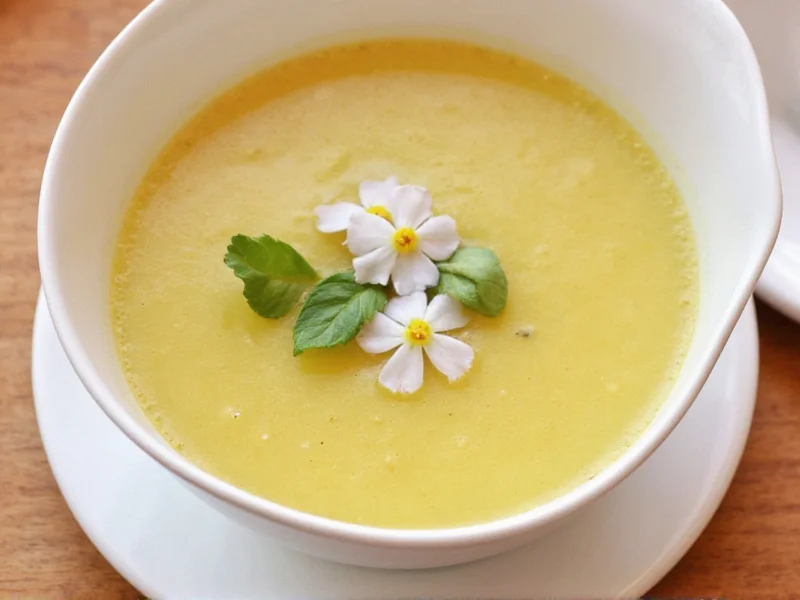The perfect egg flower soup recipe requires just 6 simple ingredients: chicken or vegetable broth, eggs, cornstarch, sesame oil, salt, and white pepper. This authentic Chinese soup takes only 15 minutes to prepare with a silky broth and delicate egg ribbons. For best results, slowly drizzle beaten eggs into gently simmering broth while stirring in one direction to create the signature 'flower' pattern.
Egg flower soup, known as dan hua tang in Chinese cuisine, represents one of the most elegant yet accessible dishes in Chinese culinary tradition. This seemingly simple soup demonstrates how minimal ingredients can create maximum flavor when technique is mastered. Unlike Western-style egg drop soup, authentic egg flower soup features a crystal-clear broth with delicate, petal-like egg strands that give the dish its poetic name.
Essential Ingredients for Authentic Egg Flower Soup
Creating restaurant-quality egg flower soup at home starts with selecting the right ingredients. While variations exist across Chinese regions, these core components form the foundation of a perfect bowl:
| Ingredient | Quantity | Key Purpose |
|---|---|---|
| Homemade chicken broth | 4 cups | Provides clear, flavorful base (avoid store-bought for best results) |
| Large eggs | 2 | Creates the signature 'flower' pattern when properly incorporated |
| Cornstarch | 1 tablespoon | Thickens broth to ideal silky consistency |
| Sesame oil | 1 teaspoon | Adds authentic nutty aroma (never substitute with other oils) |
| White pepper | 1/4 teaspoon | Provides subtle heat without darkening the broth |
| Salt | To taste | Enhances overall flavor profile |
Step-by-Step Preparation Guide
Mastering egg flower soup requires attention to timing and technique. Follow these professional steps for perfect results every time:
- Prepare the broth: Heat 4 cups of homemade chicken or vegetable broth in a medium saucepan until it reaches a gentle simmer (not boiling). Skim any impurities that rise to the surface.
- Create the slurry: In a small bowl, whisk 1 tablespoon cornstarch with 2 tablespoons cold water until completely smooth. This prevents lumps in your final soup.
- Thicken the broth: Slowly pour the cornstarch slurry into the simmering broth while stirring constantly. Continue cooking for 1-2 minutes until the broth becomes slightly translucent and coats the back of a spoon.
- Prepare the eggs: Beat 2 large eggs thoroughly in a separate bowl until completely uniform in color and texture. Professional chefs recommend adding 1 teaspoon of water per egg to create lighter, more delicate strands.
- Create the egg flowers: Reduce heat to low. Slowly drizzle the beaten eggs into the broth while stirring the soup in one consistent direction. Do not stir back and forth. The eggs should form beautiful ribbons as they cook instantly upon contact with the hot broth.
- Finish the soup: Remove from heat immediately after adding the eggs. Stir in 1 teaspoon sesame oil, 1/4 teaspoon white pepper, and salt to taste. Never add additional heat after incorporating the eggs, as this will cause curdling.
Professional Cooking Techniques
Several subtle techniques separate authentic egg flower soup from ordinary versions:
- Temperature control: Maintain broth at 180-190°F (82-88°C) when adding eggs. Boiling broth will create scrambled eggs rather than delicate strands.
- Drizzling method: Hold your bowl of beaten eggs 12-18 inches above the pot and pour in a thin, steady stream while stirring the broth in one direction. This creates the signature 'flower' pattern.
- Broth clarity: Use homemade broth strained through cheesecloth for crystal-clear results. Avoid adding酱油 (soy sauce) which would darken the traditional pale broth.
- Timing precision: The entire egg incorporation process should take no more than 15 seconds. Remove from heat immediately after adding eggs.
Common Variations and Adaptations
While the classic version remains beloved, these authentic regional variations offer delicious alternatives:
- Cantonese style: Adds finely shredded cooked chicken and wood ear mushrooms for texture contrast
- Sichuan variation: Includes a small amount of chili oil for subtle heat while maintaining the clear broth
- Vegan adaptation: Substitute vegetable broth and replace eggs with silken tofu cut into thin ribbons
- Winter warmer: Incorporates fresh ginger slices during broth preparation for added warmth
Troubleshooting Common Issues
Even experienced cooks encounter challenges with egg flower soup. Here's how to solve frequent problems:
- Curdled eggs: Broth was too hot when adding eggs. Solution: Let broth cool slightly (to 180°F) before adding eggs.
- Muddy broth: Cornstarch wasn't properly mixed. Solution: Always create a smooth slurry with cold water first.
- No flower pattern: Eggs added too quickly or broth not hot enough. Solution: Drizzle slowly from height while maintaining proper temperature.
- Bland flavor: Broth lacked depth. Solution: Simmer broth with a piece of dried shiitake mushroom for 20 minutes before making soup.
Serving Suggestions
Egg flower soup serves as both a standalone light meal and an elegant starter. For traditional presentation:
- Serve immediately in pre-warmed bowls to maintain ideal temperature
- Garnish with finely sliced green onions for color contrast
- Pair with steamed rice and stir-fried vegetables for a complete meal
- Enjoy as the first course in a multi-dish Chinese banquet
This versatile soup also makes an excellent base for adding other ingredients. Many home cooks incorporate cooked shrimp, crab meat, or finely shredded pork for added protein. The key to maintaining authenticity remains preserving the delicate egg ribbons and clear broth that define this classic dish.











 浙公网安备
33010002000092号
浙公网安备
33010002000092号 浙B2-20120091-4
浙B2-20120091-4